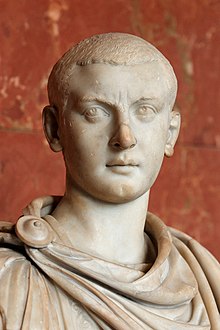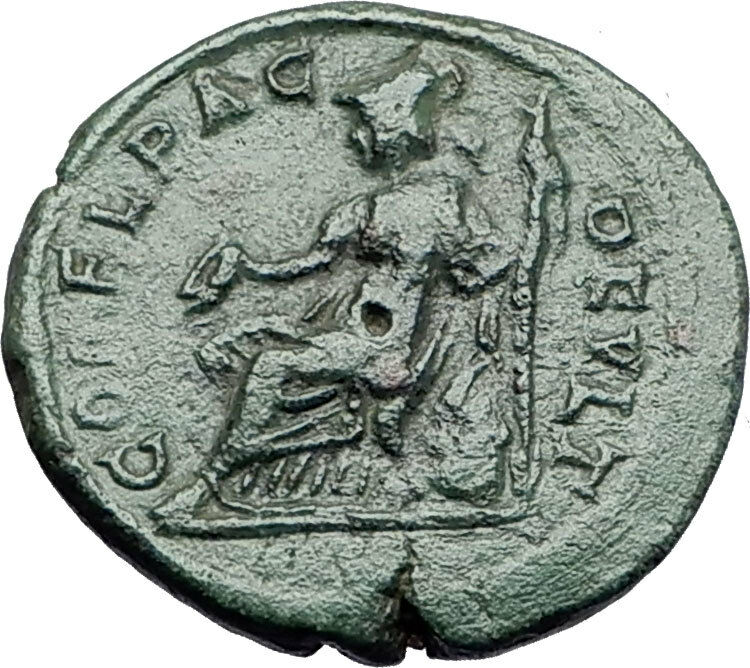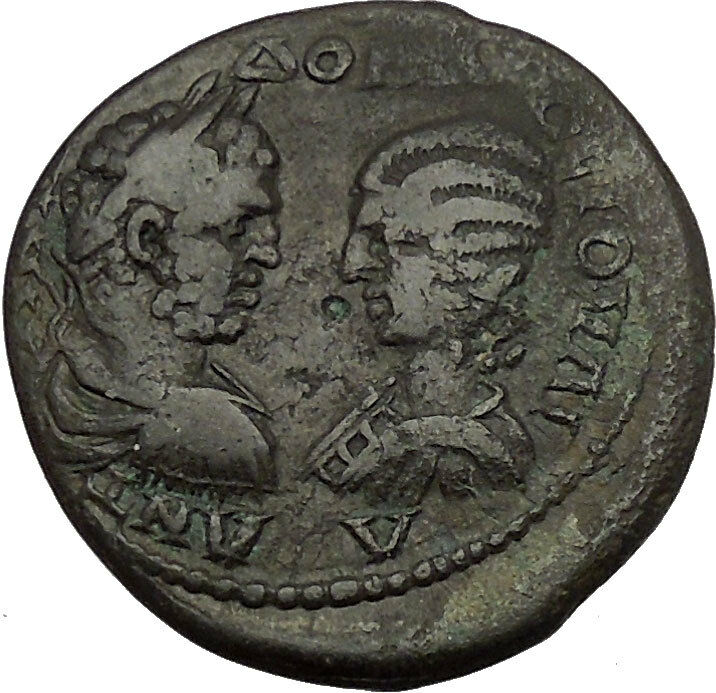|
Gordian III – Roman Emperor: 238-244 A.D.
Bronze 23mm (5.48 grams) of Edessa in Macedonia, circa 238-244 A.D.
Reference: Varbanov 3671 var.
AV K M ANTINOC ΓΟΡΔΙΑΝΟC, Laureate, draped and cuirassed bust right.
ЄΔЄCCЄΩN, Roma seated left, on cuirass, holding Nike; crowned by Edessa standing left behind holding wreath and cornucopia.
You are bidding on the exact item pictured, provided with a Certificate of Authenticity and Lifetime Guarantee of Authenticity.
_-_Google_Art_Project.jpg/260px-Peter_Paul_Rubens_-_Abundance_(Abundantia)_-_Google_Art_Project.jpg) The cornucopia (from Latin cornu copiae) or horn of plenty is a symbol of abundance and nourishment, commonly a large horn-shaped container overflowing with produce, flowers or nuts. The horn originates from classical antiquity, it has continued as a symbol in Western art, and it is particularly associated with the Thanksgiving holiday in North America. The cornucopia (from Latin cornu copiae) or horn of plenty is a symbol of abundance and nourishment, commonly a large horn-shaped container overflowing with produce, flowers or nuts. The horn originates from classical antiquity, it has continued as a symbol in Western art, and it is particularly associated with the Thanksgiving holiday in North America.
Mythology offers multiple explanations of the origin of the cornucopia. One of the best-known involves the birth and nurturance of the infant Zeus, who had to be hidden from his devouring father Kronus. In a cave on Mount Ida on the island of Crete, baby Zeus was cared for and protected by a number of divine attendants, including the goat Amalthea (“Nourishing Goddess”), who fed him with her milk. The suckling future king of the gods had unusual abilities and strength, and in playing with his nursemaid accidentally broke off one of her horns, which then had the divine power to provide unending nourishment, as the foster mother had to the god.
In another myth, the cornucopia was created when Heracles (Roman Hercules) wrestled with the river god Achelous and wrenched off one of his horns; river gods were sometimes depicted as horned. This version is represented in the Achelous and Hercules mural painting by the American Regionalist artist Thomas Hart Benton.
The cornucopia became the attribute of several Greek and Roman deities, particularly those associated with the harvest, prosperity, or spiritual abundance, such as personifications of Earth (Gaia or Terra); the child Plutus, god of riches and son of the grain goddess Demeter; the nymph Maia; and Fortuna, the goddess of luck, who had the power to grant prosperity. In Roman Imperial cult, abstract Roman deities who fostered peace (pax Romana) and prosperity were also depicted with a cornucopia, including Abundantia, “Abundance” personified, and Annona, goddess of the grain supply to the city of Rome. Pluto, the classical ruler of the underworld in the mystery religions, was a giver of agricultural, mineral and spiritual wealth, and in art often holds a cornucopia to distinguish him from the gloomier Hades, who holds a drinking horn instead.
 In Greek mythology, Nike was a goddess who personified victory, also known as the Winged Goddess of Victory. The Roman equivalent was Victoria. Depending upon the time of various myths, she was described as the daughter of Pallas (Titan) and Styx (Water) and the sister of Kratos (Strength), Bia (Force), and Zelus (Zeal). Nike and her siblings were close companions of Zeus, the dominant deity of the Greek pantheon. According to classical (later) myth, Styx brought them to Zeus when the god was assembling allies for the Titan War against the older deities. Nike assumed the role of the divine charioteer, a role in which she often is portrayed in Classical Greek art. Nike flew around battlefields rewarding the victors with glory and fame. In Greek mythology, Nike was a goddess who personified victory, also known as the Winged Goddess of Victory. The Roman equivalent was Victoria. Depending upon the time of various myths, she was described as the daughter of Pallas (Titan) and Styx (Water) and the sister of Kratos (Strength), Bia (Force), and Zelus (Zeal). Nike and her siblings were close companions of Zeus, the dominant deity of the Greek pantheon. According to classical (later) myth, Styx brought them to Zeus when the god was assembling allies for the Titan War against the older deities. Nike assumed the role of the divine charioteer, a role in which she often is portrayed in Classical Greek art. Nike flew around battlefields rewarding the victors with glory and fame.
Nike is seen with wings in most statues and paintings. Most other winged deities in the Greek pantheon had shed their wings by Classical times. Nike is the goddess of strength, speed, and victory. Nike was a very close acquaintance of Athena, and is thought to have stood in Athena’s outstretched hand in the statue of Athena located in the Parthenon. Nike is one of the most commonly portrayed figures on Greek coins.
Names stemming from Nike include amongst others: Nicholas, Nicola, Nick, Nikolai, Nils, Klaas, Nicole, Ike, Niki, Nikita, Nika, Niketas, and Nico.

In ancient Roman religionn, Roma was a female deity who personified the city of Rome and more broadly, the Roman state. “As personification, as goddess or as symbol, the name Roma stretches from classical Greece to Mussolini’s Fascist propaganda… Roma has been seen as a goddess, a whore, a near-saint, and as the symbol of civilization itself. She remains the oldest continuous political-religious symbol in Western civilization.” Ronald Mellor, Introduction, The goddess Roma.
The earliest certain cult to dea Roma was established at Smyrna in 195 BCE, probably to mark Rome’s successful alliance against Antiochus III. Mellor has proposed her cult as a form of religio-political diplomacy which adjusted traditional Graeco-Eastern monarchic honours to Republican mores: honours addressed to the divine personification of the Roman state acknowledged the authority of its offices, Republic and city as divine and eternal.
Democratic city-states such as Athens and Rhodes accepted Roma as analogous to their traditional cult personifications of the demos (ordinary people). In 189 BCE, Delphi and Lycia instituted festivals in her honour. Roma as “divine sponsor” of athletics and pan-Hellenic culture seems to have dovetailed neatly into a well-established and enthusiastic festival circuit, and temples to her were outnumbered by her civic statues and dedications. In 133 BCE Attalus III bequeathed the people and territories of Pergamon to Rome, as to a trusted ally and protector. The Pergamene bequest became the new Roman province of Asia, and Roma’s cult spread rapidly within it.
In Hellenistic religious tradition, gods were served by priests and goddesses by priestesses but Roma’s priesthood was male, perhaps in acknowledgment of the virility of Rome’s military power. Priesthood of the Roma cult was competed among the highest ranking local elites. In contrast to her putative “Amazonian” Roman original, Greek coinage depicts Roma in the “dignified and rather severe style” of a Greek goddess, often wearing a mural crown, or sometimes a Phrygian helmet. She is occasionally bareheaded. In this and later periods, she was often associated with Zeus (as guardian of oaths) and Fides (the personification of mutual trust). Her Eastern cult appealed for Rome’s loyalty and protection – there is no reason to suppose this as other than genuine (and diplomatically sound) respect. A panegyric to her survives, in five Sapphic stanzas attributed to Melinno. In Republican Rome and its Eastern colonae her cult was virtually non-existent.
Roma was thus absorbed into the earliest (Eastern) form of “Imperial cult” – or, from an Eastern viewpoint, the cult to Augustus was grafted onto their time-honoured cult to Roma. From here on, she increasingly took the attributes of an Imperial or divine consort to the Imperial divus, but some Greek coin types show her as a seated or enthroned authority, and the Imperial divus standing upright as her supplicant or servant.The Imperial cult arose as a pragmatic and ingenious response to an Eastern initiative. It blended and “renewed” ancient elements of traditional religions and Republican government to create a common cultural framework for the unification of Empire as a Principate. In the West, this was a novelty, as the Gauls, Germans and Celts had no native precedent for ruler cult or a Roman-style administration.
The foundation of the Imperial cult centre at Lugdunum introduced Roman models for provincial and municipal assemblies and government, a Romanised lifestyle, and an opportunity for local elites to enjoy the advantages of citizenship through election to Imperial cult priesthood, with an ara (altar) was dedicated to Roma and Augustus. Thereafter, Roma is well attested by inscriptions and coinage throughout the Western provinces. Literary sources have little to say about her, but this may reflect her ubiquity rather than neglect: in the early Augustan era, she may have been honoured above her living Imperial consort.
In the city of Rome itself, the earliest known state cult to dea Roma was combined with cult to Venus at the Hadrianic Temple of Venus and Roma. This was the largest temple in the city, probably dedicated to inaugurate the reformed festival of Parilia, which was known thereafter as the Romaea after the Eastern festival in Roma’s honour. The temple contained the seated, Hellenised image of dea Roma – the Palladium in her right hand symbolised Rome’s eternity. In Rome, this was a novel realisation. Greek interpretations of Roma as a dignified deity had transformed her from a symbol of military dominance to one of Imperial protection and gravitas.
Gordian III – Roman Emperor: 238-244 A.D.
Caesar: 238 A.D. (under Balbinus and Pupienus)
Augustus: 238-244 A.D.
| Grandson of Gordian I | Nephew of Gordian II | Adopted Successor of Balbinus and Pupienus | Husband of Tranquillina |

Gordian III (Latin: Marcus Antonius Gordianus Pius Augustus; 20 January 225 AD – 11 February 244 AD) was Roman Emperor from 238 AD to 244 AD. At the age of 13, he became the youngest sole legal Roman emperor throughout the existence of the united Roman Empire. Gordian was the son of Antonia Gordiana and an unnamed Roman Senator who died before 238. Antonia Gordiana was the daughter of Emperor Gordian I and younger sister of Emperor Gordian II. Very little is known of his early life before his acclamation. Gordian had assumed the name of his maternal grandfather in 238 AD.
In 235, following the murder of Emperor Alexander Severus in Moguntiacum (modern Mainz), the capital of the Roman province Germania Superior, Maximinus Thrax was acclaimed Emperor. In the following years, there was a growing opposition against Maximinus in the Roman senate and amongst the majority of the population of Rome. In 238 a rebellion broke out in the Africa Province, where Gordian’s grandfather and uncle, Gordian I and II, were proclaimed joint emperors. This revolt was suppressed within a month by Cappellianus, governor of Numidia and a loyal supporter of Maximinus Thrax. The elder Gordians died, but public opinion cherished their memory as peace-loving and literate men, victims of Maximinus’ oppression.
Meanwhile, Maximinus was on the verge of marching on Rome and the Senate elected Pupienus and Balbinus as joint emperors. These senators were not popular men and the population of Rome was still shocked by the elder Gordian’s fate, so the Senate decided to take the teenager Gordian, rename him Marcus Antonius Gordianus like his grandfather, and raise him to the rank of Caesar and imperial heir. Pupienus and Balbinus defeated Maximinus, mainly due to the defection of several legions, particularly the II Parthica, who assassinated Maximinus. However, their joint reign was doomed from the start with popular riots, military discontent and an enormous fire that consumed Rome in June 238. On July 29, Pupienus and Balbinus were killed by the Praetorian Guard and Gordian proclaimed sole emperor.
Rule
Due to Gordian’s age, the imperial government was surrendered to the aristocratic families, who controlled the affairs of Rome through the Senate. In 240, Sabinianus revolted in the African province, but the situation was quickly brought under control. In 241, Gordian was married to Furia Sabinia Tranquillina, daughter of the newly appointed praetorian prefect, Timesitheus. As chief of the Praetorian Guard and father in law of the Emperor, Timesitheus quickly became the de facto ruler of the Roman Empire.
In the 3rd century, the Roman frontiers weakened against the Germanic tribes across the Rhine and Danube, and the Sassanid Empire across the Euphrates increased its own attacks. When the Persians under Shapur I invaded Mesopotamia, the young emperor opened the doors of the Temple of Janus for the last time in Roman history, and sent a large army to the East. The Sassanids were driven back over the Euphrates and defeated in the Battle of Resaena (243). The campaign was a success and Gordian, who had joined the army, was planning an invasion of the enemy’s territory, when his father-in-law died in unclear circumstances. Without Timesitheus, the campaign, and the Emperor’s security, were at risk.
Gaius Julius Priscus and, later on, his own brother Marcus Julius Philippus, also known as Philip the Arab, stepped in at this moment as the new Praetorian Prefects and the campaign proceeded. Around February 244, the Persians fought back fiercely to halt the Roman advance to Ctesiphon. Persian sources claim that a battle occurred (Battle of Misiche) near modern Fallujah (Iraq) and resulted in a major Roman defeat and the death of Gordian III. Roman sources do not mention this battle and suggest that Gordian died far away from Misiche, at Zaitha (Qalat es Salihiyah) in northern Mesopotamia. Modern scholarship does not unanimously accept this course of the events. One view holds that Gordian died at Zaitha, murdered by his frustrated army, while the role of Philip is unknown. Other scholars, such as Kettenhofen, Hartman and Winter have concluded that Gordian died in battle against the Sassanids.
Philip transferred the body of the deceased emperor to Rome and arranged for his deification. Gordian’s youth and good nature, along with the deaths of his grandfather and uncle and his own tragic fate at the hands of the enemy, earned him the lasting esteem of the Romans. The soldiers held Gordian in high esteem, as he had possibly sacrificed his life to save them in 244.
|





_-_Google_Art_Project.jpg/260px-Peter_Paul_Rubens_-_Abundance_(Abundantia)_-_Google_Art_Project.jpg) The cornucopia (from Latin cornu copiae) or horn of plenty is a symbol of abundance and nourishment, commonly a large horn-shaped container overflowing with produce, flowers or nuts. The horn originates from classical antiquity, it has continued as a symbol in Western art, and it is particularly associated with the Thanksgiving holiday in North America.
The cornucopia (from Latin cornu copiae) or horn of plenty is a symbol of abundance and nourishment, commonly a large horn-shaped container overflowing with produce, flowers or nuts. The horn originates from classical antiquity, it has continued as a symbol in Western art, and it is particularly associated with the Thanksgiving holiday in North America. In Greek mythology, Nike was a goddess who personified victory, also known as the Winged Goddess of Victory. The Roman equivalent was Victoria. Depending upon the time of various myths, she was described as the daughter of Pallas (Titan) and Styx (Water) and the sister of Kratos (Strength), Bia (Force), and Zelus (Zeal). Nike and her siblings were close companions of Zeus, the dominant deity of the Greek pantheon. According to classical (later) myth, Styx brought them to Zeus when the god was assembling allies for the Titan War against the older deities. Nike assumed the role of the divine charioteer, a role in which she often is portrayed in Classical Greek art. Nike flew around battlefields rewarding the victors with glory and fame.
In Greek mythology, Nike was a goddess who personified victory, also known as the Winged Goddess of Victory. The Roman equivalent was Victoria. Depending upon the time of various myths, she was described as the daughter of Pallas (Titan) and Styx (Water) and the sister of Kratos (Strength), Bia (Force), and Zelus (Zeal). Nike and her siblings were close companions of Zeus, the dominant deity of the Greek pantheon. According to classical (later) myth, Styx brought them to Zeus when the god was assembling allies for the Titan War against the older deities. Nike assumed the role of the divine charioteer, a role in which she often is portrayed in Classical Greek art. Nike flew around battlefields rewarding the victors with glory and fame.






